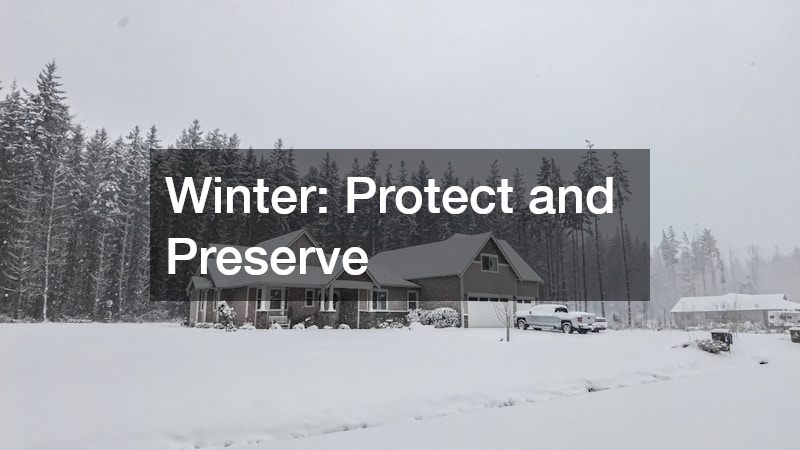Owning a home is a dream come true for many, but keeping it in great condition requires consistent care and attention throughout the year. Many homeowners make the mistake of waiting until something breaks before calling for help—but that reactive approach often leads to costly, avoidable repairs. Whether it’s a leaky pipe, a jammed garage door, or a failing water heater, neglecting routine maintenance can quickly drain your savings.
Seasonal home maintenance is the key to preserving your property’s comfort, safety, and value. By taking small but strategic steps each season, you can prevent problems before they start, extend the life of your home systems, and avoid major repair bills down the road. Local professionals—from plumbers to roofers and builders—agree that proactive care beats expensive fixes every time.
This guide will walk you through seasonal home maintenance essentials recommended by experienced contractors and preventive maintenance companies. From winter readiness to summer upgrades, here’s how to keep your home in top shape year-round.
Why Seasonal Maintenance Matters
Every season brings unique challenges that test your home’s durability. Hot summers strain cooling systems, while freezing winters can damage pipes and foundations. The shift between dry and wet weather can also affect structural integrity, paint, and even indoor air quality.
Here’s why staying on top of maintenance matters:
-
Prevents Costly Emergencies: Regular inspections by a trusted plumbing contractor, roofer, or HVAC technician help identify small issues—like leaks or rust—before they turn into large-scale damage.
-
Saves Money: A small investment in upkeep often saves thousands in repairs. For example, cleaning gutters regularly costs less than fixing a water-damaged ceiling.
-
Protects Your Home’s Value: A well-maintained home not only feels safer and more comfortable but also attracts higher resale value.
-
Improves Energy Efficiency: Sealing windows, insulating pipes, and maintaining appliances help reduce your energy bills all year long.
In fact, experts estimate that regular home maintenance can cut repair costs by up to 30% annually. Seasonal care ensures your home adapts to temperature shifts and weather extremes without unnecessary wear or breakdowns.
Spring: Refresh and Repair

As winter fades, spring provides the perfect opportunity to assess your home for damage caused by ice, wind, or moisture. This is the time to clean, inspect, and rejuvenate both the interior and exterior of your property.
1. Plumbing and Heating Systems
After months of heavy use, it’s wise to inspect your water and heating systems. Fluctuating temperatures can cause minor leaks or cracks in pipes. Check under sinks and around water heaters for any dampness or corrosion.
If your water heater is outdated or inefficient, consider scheduling a water heater installation. Modern, energy-efficient models not only save money on utilities but also reduce the risk of breakdowns during the next cold season.
2. Lawn and Outdoor Equipment
Spring is also the season to prepare your yard for lush growth. Sharpen mower blades, replace spark plugs, and change oil on your riding lawn mower before you start cutting grass regularly. Proper maintenance extends the machine’s lifespan and ensures a clean, even trim.
3. Windows and Glass
Inspect your home’s windows and glass doors for cracks or condensation buildup—signs of poor insulation. Schedule a custom glass replacement if necessary to improve energy efficiency and enhance curb appeal. Fresh, clear windows make your home brighter and can help maintain indoor temperatures more effectively.
4. Pool and Patio Prep
For homeowners with pools or outdoor spaces, spring is the ideal time to get things ready. Reach out to pool builders for a quick inspection or maintenance service before reopening your pool. Clean decks, reseal wooden surfaces, and test your outdoor lighting for safety.
Pro Tip: Local contractors often offer spring maintenance packages that combine plumbing checks, outdoor repairs, and inspections—perfect for getting your home back in shape after winter.
Summer: Maximize Comfort and Efficiency

Summer brings longer days, warmer temperatures, and plenty of opportunities to enjoy your outdoor spaces. It’s also the season when heat, humidity, and frequent usage put extra pressure on your home systems.
1. Sun Protection and Cooling
If your home gets too hot during summer afternoons, consider contacting a local sun shade company. Installing sun shades, awnings, or pergolas can reduce glare, keep indoor temperatures cooler, and lower energy bills. These additions also make patios and porches more comfortable for entertaining guests.
2. Plumbing and Water Systems
Higher temperatures and increased water use can stress your plumbing. Have a plumbing contractor inspect outdoor faucets, irrigation systems, and sprinkler heads for leaks. Addressing minor drips now can prevent wasted water and foundation erosion.
3. Septic and Drainage
Summer is also a good time to schedule septic system services. Routine pumping and inspections prevent backups, odors, and costly damage later in the year. Since septic systems tend to be heavily used during family gatherings or vacations, proactive care ensures uninterrupted function.
4. Pool and Outdoor Fun
If you have a pool, weekly cleaning and pH testing are essential. Minor repairs—like sealing cracks or replacing worn-out filters—shouldn’t be ignored. Professional pool builders often offer maintenance packages that keep your pool sparkling and safe.
5. Garage and Driveway
Lubricate hinges, rollers, and tracks to keep your garage door functioning smoothly. Regular garage door repairs—such as replacing weatherstripping or sensors—prevent sudden malfunctions that can trap your vehicle or damage the opener.
Expert Tip: Many local pros recommend scheduling a mid-summer maintenance check. Heat and humidity can accelerate wear on exterior materials, so catching issues early can save significant repair costs.
Fall: Prepare for Cold Weather

As temperatures drop and leaves start to fall, it’s time to transition your home for the coming winter. Fall maintenance focuses on sealing, insulating, and safeguarding systems that could suffer in freezing conditions.
1. Heating System and Water Heater
Before the cold sets in, ensure your heating system is working properly. Replace air filters, test thermostats, and inspect ducts for leaks. It’s also a good time to check your water heater—consider an upgrade or new water heater installation if yours is outdated or struggling to keep up. Energy-efficient models can reduce heating costs throughout the winter.
2. Garage Door and Weatherproofing
Don’t wait for the first freeze to check your garage door. Schedule garage door repairs to fix alignment issues, frayed cables, or broken seals. Add insulation to prevent drafts from entering your home through connected garages.
3. Firewood and Fireplace Readiness
If you have a fireplace, stock up on firewood for sale before prices climb. Choose seasoned firewood to minimize smoke and improve heating efficiency. Clean the chimney and inspect the flue for blockages to reduce fire hazards.
4. Roof and Gutter Cleaning
Clear out leaves, twigs, and debris from gutters to prevent blockages and water damage. Check your roof for missing or damaged shingles, as small issues can quickly worsen under snow and ice.
5. Yard and Equipment Storage
Before winter arrives, properly store your riding lawn mower, garden hoses, and outdoor furniture. Clean and cover equipment to prevent rust and deterioration.
Fall Checklist:
-
Seal cracks in windows, siding, and doors.
-
Drain outdoor faucets and sprinkler systems.
-
Test smoke and carbon monoxide detectors.
-
Reverse the ceiling fan direction to circulate warm air.
Taking care of these small tasks in autumn sets you up for a safer, warmer, and more efficient winter.
Winter: Protect and Preserve

Winter can be harsh on your home, especially in regions with heavy snowfall, freezing temperatures, and ice accumulation. The key to minimizing damage is preparation.
1. Snow and Ice Management
If you own snow removal equipment, have it serviced early. Schedule snow plow repairs or maintenance to ensure your machine runs smoothly when you need it most. Stock up on salt, sand, or de-icing solutions for your driveway and sidewalks.
2. Plumbing and Insulation
Freezing temperatures are notorious for causing burst pipes. Keep your home warm enough to prevent freezing, even when you’re away. Insulate exposed pipes and leave cabinet doors open to allow warm air circulation. Consult a plumbing contractor to inspect vulnerable areas, such as crawl spaces and basements, for potential leaks or weak spots.
3. Windows and Glass Care
Check for drafts near windows and doors. If you feel cold air entering or see condensation between panes, it may be time for a custom glass replacement. Upgraded glass helps maintain warmth indoors and lowers energy costs.
4. Fireplace and Heating Safety
Before lighting your first fire, ensure your chimney is clean and your damper opens properly. Burn only seasoned firewood for sale to reduce creosote buildup and smoke. Keep a fire extinguisher nearby and install carbon monoxide detectors in rooms with heating equipment.
5. Septic and Outdoor Systems
Winter weather can strain your plumbing and septic systems. Avoid overloading drains and minimize grease disposal to prevent clogs. If your area experiences heavy snow, mark your septic tank location so you can avoid parking or piling snow on it. Regular septic system services before winter can prevent freezing or flooding.
6. Emergency Preparedness
Power outages and severe weather can happen anytime. Keep flashlights, batteries, bottled water, and blankets in an accessible location. Program important numbers—like your preventive maintenance companies, local plumbers, and electricians—into your phone for quick access.
By taking these precautions, you’ll safeguard your home from costly winter disasters and stay comfortable no matter how cold it gets outside.
Expert Insights: What Local Pros Want Homeowners to Know
Local contractors and technicians understand the challenges of maintaining homes through changing seasons. Here are some practical insights from various professionals:
-
Pool Builders: “Year-round pool care doesn’t have to be complicated. Keeping filters clean and water chemistry balanced extends equipment life and prevents costly mid-season repairs.”
-
Plumbing Contractors: “The most expensive plumbing issues we see usually start as small leaks. Scheduling seasonal inspections—even if nothing seems wrong—can save homeowners thousands.”
-
Local Sun Shade Companies: “Shade structures not only make outdoor spaces more comfortable, they also protect furniture and reduce indoor cooling costs during summer.”
-
Garage Door Technicians: “Lubrication is everything. A quick tune-up before winter ensures your garage door won’t freeze or jam when you least expect it.”
Working with local experts has its advantages. They’re familiar with your area’s specific climate patterns, know the most common issues homeowners face, and can recommend maintenance schedules tailored to local conditions. Building long-term relationships with reliable service providers—like plumbers, roofers, or heating specialists—ensures consistent care and faster response times when emergencies arise.
How to Build a Year-Round Home Maintenance Schedule
Creating a clear, organized home maintenance schedule is one of the best ways to stay on top of seasonal upkeep. Instead of scrambling when problems arise, you’ll know exactly what needs attention—and when. A proactive maintenance plan keeps your home in top shape, helps you budget effectively, and ensures that no system is neglected for too long.
Here’s a simple approach to get started:
-
List your seasonal tasks: Break down your to-dos by season—spring cleaning, summer cooling checks, fall inspections, and winter prep.
-
Set reminders: Use digital calendars or apps to schedule reminders for annual services like HVAC inspections, garage door repairs, or septic system services.
-
Hire local experts early: Book services with trusted contractors such as pool builders or plumbing contractors before peak seasons when schedules fill quickly.
-
Keep records: Maintain a home maintenance journal or spreadsheet noting service dates, contractors, and costs to track your upkeep history.
-
Review annually: At the end of each year, assess what worked well and what needs improvement in your maintenance routine.
By maintaining a structured schedule, homeowners can prevent overlooked issues, extend the lifespan of essential systems, and enjoy peace of mind throughout the year.
Conclusion: Year-Round Care for a Trouble-Free Home
A well-maintained home doesn’t just happen—it’s the result of consistent effort and a smart, seasonal maintenance plan. Taking the time to inspect, repair, and prepare your home for each season saves you from unexpected headaches and major expenses.
Whether it’s scheduling septic system services before the holidays, arranging custom glass replacement to stop drafts, or planning a new water heater installation for greater efficiency, proactive care is the smartest investment you can make.
Partnering with trusted local professionals, such as preventive maintenance companies and certified contractors, ensures every part of your home—from your plumbing to your outdoor spaces—remains in top condition. They bring the tools, knowledge, and experience needed to spot issues you might miss and fix them before they become major problems.
At the end of the day, your home is more than just a structure—it’s your family’s comfort zone and your biggest asset. With regular seasonal maintenance, expert support, and a proactive mindset, you can enjoy a safe, efficient, and worry-free home all year long.
So before the next season begins, take a walk around your property, make a checklist, and schedule your maintenance tasks in advance. The small effort you put in today will reward you with long-term peace of mind—and protect your home from costly repairs for years to come.











